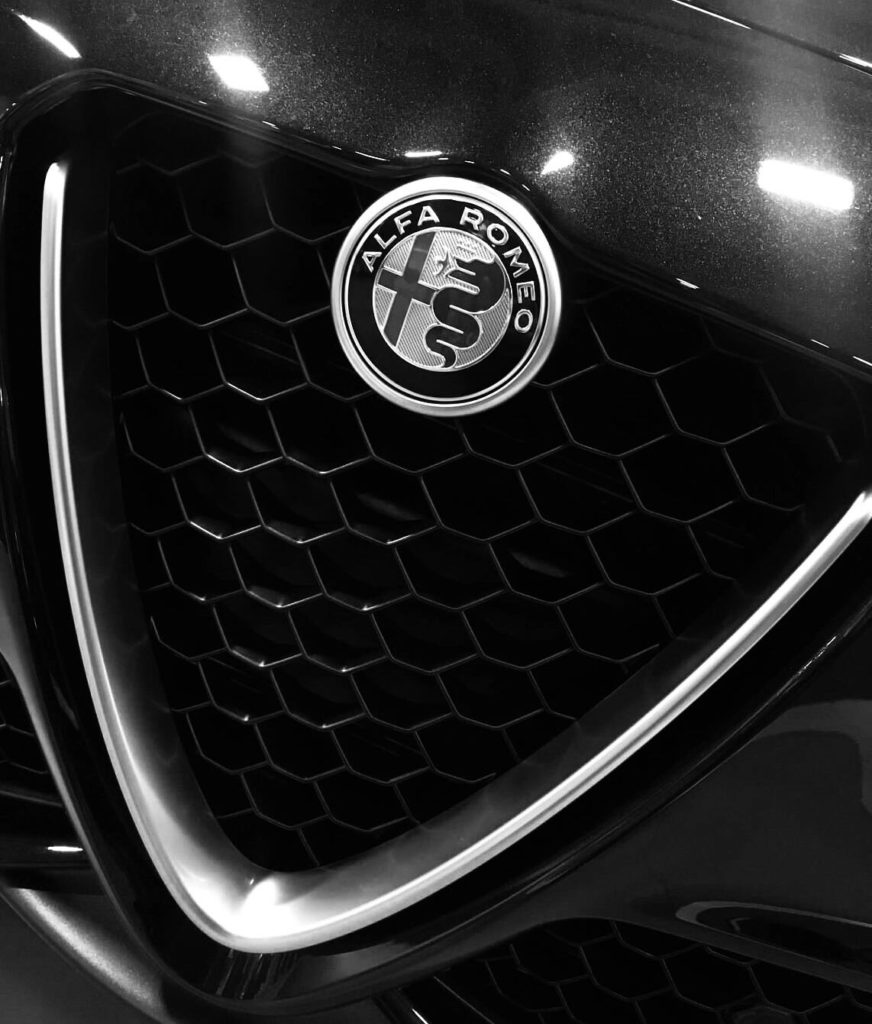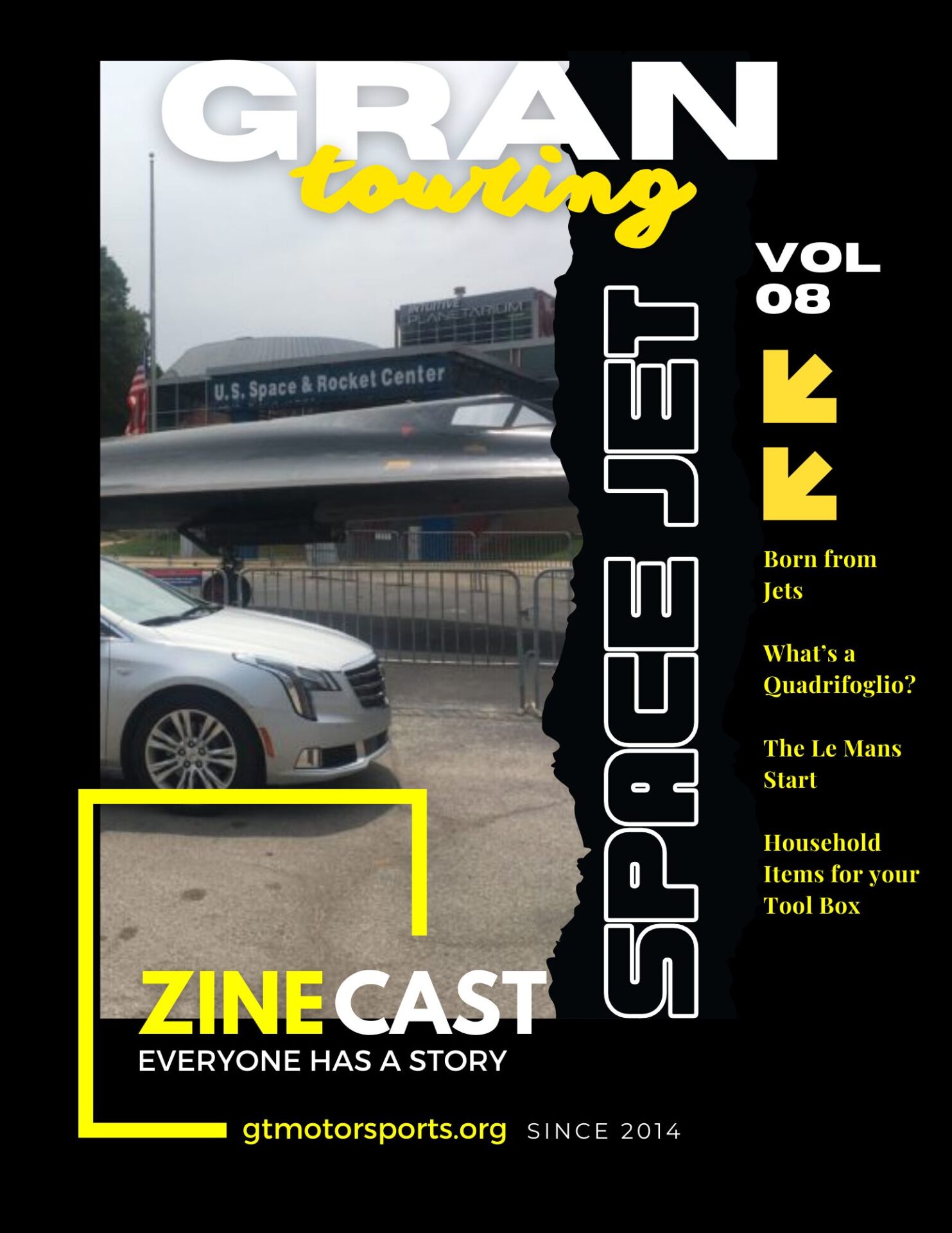On a recent business trip with my boss and fellow petrol-head, he always asks me questions like “if you had to buy a car today, something sporty, but can still take the kids to school – what would you buy?” – I usually pause for a moment and my answer is always the same “to be a master petrol-head, it is said one must own an Alfa” – and until recently, family-sized Alfa’s weren’t something readily available in the US. Growing up with a huge crush on the GTV-6, I’ve always wanted an Alfa but figured no way, no how. That being said, thanks to the merger between FIAT and Chrysler in 2013, we have started to see Alfas return to the US for the first time since the early ‘90s.
Expanding on my answer to my boss, I add “and more specifically, the Giulia”. Its such a handsome car, some would say too masculine, but very Italian. Usually, my boss will smile at my response and we spiral into all sorts of other alternatives, because as I’ve mentioned before, he’s 6’7” which makes “fitment” a real challenge. His current daily is a supercharged Land Rover Discovery LR4, last of the line, and perfect for his Scottish heritage and Viking stature.
Unlike previous rounds of “what car should I buy?” this time he responds “funny you mention the Alfa again… we saw one on the road the other day and my wife turns to me and says ‘honey, what is that?’ – to which I replied ‘an Alfa, very chic’ – and she returned with ‘is it an Irish car?’ – To which I replied (with gusto) ‘no, its Italian!’ then she says ‘then, if its Italian, how come it has a shamrock on it?’” #noncarpeople – We shared a laugh and moved on with the conversation.
It did have me thinking, What’s in a name? – I’m sure many of us recognize the insignia but do we really know the backstory? Therefore, lets spend a couple minutes talking about the Alfa name, the logo and why an Italian auto maker chose a 4-leaf-clover to represent their brand.
Alfa Romeo
Alfa Romeo (pnn: “Alpha Row-may-oh” ) was founded by Frenchman Alexandre Darracq originally as Società Anonima Italiana Darracq (SAID) in 1906 and morphed into A.L.F.A. (“[Società] Anonima Lombarda Fabbrica Automobili” which roughly translates to “Anonymous Lombard Automobile Factory”) on 24 June 1910, in Milan, Italy. 5 years later entrepreneur Nicola Romeo, would take control of A.L.F.A in 1915 and graft his last name to the new merger. Like a marriage where both parties want to keep their names, the new company would be known from then on as “ALFA-Romeo”. And contrary to petrol-head belief, Alfa has been associated with FIAT for many years, but didn’t officially become a subsidiary of FIAT until 1986. Today, Alfa is officially known as: Alfa Romeo Automobiles S.p.A.
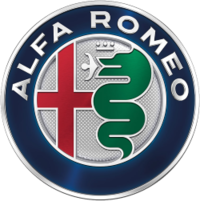
The Cross and The Snake
Now that we know the simple history of the name: Alfa Romeo, what of this cross/snake logo? Is this some reference to St. Patrick ousting the snakes from Ireland?
Actually, the Alfa logo is comprised of pieces of the coat-of-arms associated with Milan. The red-cross (easily mistaken for the flag of St. George) represents the flag of Milan

and the biscione (right bottom, pnn: “Bee-show-neh”) is a crowned viper swallowing a Moor, which is part of the emblem of the House of Visconti who ruled Milan from 1277 to 1447.
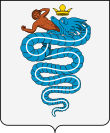
The logo was designed in 1910 by a young engineer in the Alfa office named Romano Cattaneo.
Still nothing Irish here… So what’s with this 4-leaf-clover?
The quadrifoglio (also called the ‘cloverleaf’, pnn: “Quad-ree-foe-leo” ) has been used on Alfa Romeo race cars since the death of Ugo Sivocci in 1923. Sivocci was hired by Alfa in 1920 to drive in the four-man racing team – known as Alfa Corse – with included drivers: Ugo Sivocci, Antonio Ascari, Giuseppe Campari, and Enzo Ferrari.
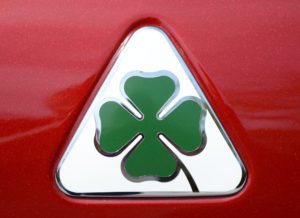
Legend has it, Sivocci was thought to be very experienced, but often followed by bad luck. His counterparts, like a lot of race car drivers, were a bit superstitious and decided to banish his bad luck by painting a white square with a green four-leaf clover in the center of the grille of his car. Sivocci had immediate success, crossing the finish line first! And so, the quadrifoglio became the symbol, the lucky charm, of the racing Alfa Romeos after that victory at the Targa Florio. Since WW2, the quadrifolio has been used to designate the higher trim models in the Alfa offerings. The first non-racing Alfa to carry the quadrifolio was the ’63 Guilia TI Super and today, the quadrifolio can be found on the front fenders above/behind the wheels of these special models. So there you have it… everything you needed to know about the famed Alfa logo and the quadrifolio!
The most recent use of the quadrifolio can be found on the wings of the Alfa Romeo Giulia, which FIAT unveiled in 2016 (below). The Giulia has quickly gained traction against rivals at Audi and BMW in the luxury-sports-sedan market, and is said to be excellent to drive. Unfortunately, we still haven’t gotten the chance to get behind the wheel of this awesome Alfa, and maybe we should start wearing quadrifolio tee-shirts to bring us better luck 😉 – All kidding aside, we hope to follow up this article with a Test Drive of this beautiful machine! In the meantime, we’ll leave you with this…
#neverstoplearning


